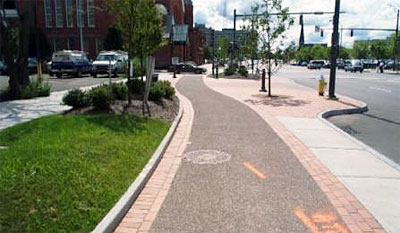Curbs and Gutters
Types of Curbs
Advantages | Types | Requirements | Design | AASHTO Standards | Joints | Drainage | Materials | Construction

Concrete curbs are generally classified as barrier curbs or mountable curbs. Either type can be constructed in many different shapes, depending on regional preferences, purposes and construction costs. Typical cross sections of the most commonly used curbs and curb and gutter sections are shown in Figure II. Barrier curbs, also known as straight curbs, resemble the stone slabs used originally for curbs and form abrupt obstacles to vehicles leaving pavements.
Mountable curbs, sometimes referred to as roll curbs, have sloping faces that allow vehicles to encroach on them without damaging tires and wheels; and if the slopes are gentle enough, cars can cross them to access driveways. Curbs that cannot be crossed without damage or discomfort must have sections where the heights of the curbs are reduced for vehicular entrances. The low portions are usually referred to as depressed curbs. When curbs are constructed in areas where buildings have already been erected and driveways established, the depressed portions can be easily designated, but in developing areas where the driveways have not been located, mountable curbs are usually preferred.
Either type of curb can have an apron or gutter section attached and become a combined curb and gutter. Combined curb and gutter sections are commonly used along streets and parking lots in urban areas, especially with asphalt pavements, to provide the advantages of stable concrete gutters with sustainable flow lines along the curbs.
Because concrete can be readily shaped to transition between cross-sections, curbs can be tapered to meet ramps for pedestrian crossings where these are preferred or to meet requirements for the disabled.
Curbs built monolithically with concrete pavements project above the pavement at the edges. These are referred to as monolithic curbs or integral curbs, as opposed to separate curbs. As the edges of concrete pavements with the added thickness of curbs are stronger and stiffer, deflections caused by heavy wheels close to the outside edges are reduced. Where curbs are cast on hardened concrete slabs, resulting in cold joints between the curbs and slabs, there are opportunities for planes of weakness and water penetration, which can result in shortened service life.
A separate curb and gutter must be tied to the pavement slab with deformed steel bars if there is to be effective load transfer. If a curb is separate from the pavement the joint between the pavement and the curb may require maintenance.


